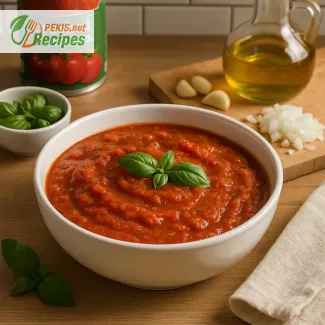
The Art of Crafting Authentic Napoli Pizza
A Slice of Tradition
Napoli pizza, also known as Neapolitan pizza, is more than just a dish—it is an embodiment of Italian culinary heritage, a time-honored tradition that dates back centuries. Originating in the vibrant city of Naples, this pizza is renowned for its thin, soft, and airy crust, its simple yet bold flavors, and its authentic preparation methods that adhere to strict guidelines. Every bite offers a perfect balance of crispness and chewiness, with a harmonious blend of sweet San Marzano tomatoes, creamy mozzarella, and fresh basil.
Unlike commercialized pizzas found worldwide, the true essence of a Napoli pizza lies in its purity. No excessive toppings, no overwhelming flavors—just a symphony of high-quality ingredients that work together to create an experience rather than just a meal. If you have ever wondered why a traditional Neapolitan pizza tastes so different from the rest, it all comes down to its meticulous preparation, artisanal techniques, and dedication to authenticity.
The Key to an Authentic Napoli Pizza
The magic of a true Neapolitan pizza lies in its dough. The preparation follows strict standards, ensuring the perfect texture and structure. The dough is made from fine Italian 00 flour, fresh yeast, water, and sea salt, allowing it to ferment slowly over hours to develop its characteristic airy and elastic consistency. This slow fermentation is key to achieving the light and flavorful crust that defines Napoli pizza.
Once prepared, the dough is hand-stretched to a thin, delicate base with a slightly raised, airy edge—what is known as the "cornicione." This crust puffs up beautifully when placed in a wood-fired oven, forming delightful charred blisters that add a smoky depth to the flavor.
The Ingredients That Define Perfection
One of the most crucial aspects of a true Napoli pizza is its high-quality ingredients. Each component plays a significant role in elevating the overall taste.
San Marzano Tomatoes – The Heart of the Sauce
Sourced from the rich volcanic soil of Mount Vesuvius, San Marzano tomatoes are known for their sweetness, low acidity, and robust flavor. These tomatoes are carefully crushed into a light sauce that is spread sparingly over the dough, allowing their natural richness to shine.
Mozzarella di Bufala – The Essence of Creaminess
The traditional choice for Napoli pizza is Mozzarella di Bufala, a cheese made from water buffalo milk. It is prized for its luxurious creaminess, delicate tang, and smooth melting quality. This cheese perfectly complements the tomato sauce, adding a layer of indulgence to every bite.
Fresh Basil and Extra Virgin Olive Oil – The Finishing Touches
A handful of fresh basil leaves scattered atop the pizza provides an aromatic contrast, infusing the dish with a subtle, peppery freshness. A light drizzle of extra virgin olive oil before serving enhances the depth and complexity of flavors, completing the masterpiece that is Napoli pizza.
The Power of a Wood-Fired Oven
The cooking process is just as important as the ingredients themselves. Traditional Napoli pizza is cooked in a wood-fired oven at an astonishing temperature of 485°C (905°F) for no longer than 90 seconds. This rapid cooking time ensures that the crust remains tender, with a slightly charred, crispy exterior while keeping the toppings fresh and vibrant.
The high heat also creates the signature airy and blistered texture, giving Napoli pizza its unmistakable look and flavor. The quick bake locks in the natural sweetness of the tomatoes, prevents the cheese from becoming rubbery, and results in a pizza that is light, digestible, and irresistibly delicious.
A Timeless Culinary Experience
Eating Napoli pizza is more than just savoring a dish—it is about embracing a centuries-old tradition that has been perfected by generations of skilled pizzaiolos. Whether enjoyed in a bustling Neapolitan pizzeria, at a cozy family dinner, or even made at home with the right ingredients and techniques, it remains an unforgettable gastronomic experience.
With its perfectly balanced flavors, artisanal craftsmanship, and deep cultural roots, Napoli pizza continues to be celebrated worldwide as the gold standard of authentic Italian pizza. Each slice tells a story of passion, heritage, and a relentless pursuit of perfection—a testament to why Napoli pizza is truly one of the most iconic dishes in the world.
- Dough Preparation: In a large bowl, dissolve the yeast in water. Gradually add flour, mixing with your hands. Once half the flour is incorporated, add the salt. Continue kneading until the dough becomes smooth and elastic. This process should take around 10 minutes.
- First Proofing: Cover the dough with a damp cloth and let it rest at room temperature for at least 8 hours to develop texture and flavor.
- Shaping the Dough: Divide the dough into two equal portions and shape each into a ball. Cover again and let rise for another 2 hours.
- Preparing the Sauce: Crush the San Marzano tomatoes by hand or with a food mill. Add a pinch of salt and set aside. Do not cook the sauce; it should remain raw.
- Stretching the Dough: On a floured surface, gently press the dough into a circular shape, keeping the edges slightly thicker for the characteristic cornicione. Do not use a rolling pin—stretch it by hand.
- Assembling the Pizza: Spread a thin layer of tomato sauce on the dough, leaving a small border. Tear the mozzarella into chunks and distribute evenly. Add fresh basil leaves. Drizzle with a little olive oil.
- Baking: Preheat a wood-fired oven to 485°C (905°F) or a home oven to the maximum temperature (usually around 250°C/480°F). Bake in a wood-fired oven for 60-90 seconds or in a home oven for 7-10 minutes, using a pizza stone if possible.
- Serving: Once baked, drizzle with more olive oil and serve immediately.
Enhancing the Classic Neapolitan Pizza Recipe
Elevating the Dough for a Superior Crust
The foundation of any great Neapolitan pizza is the dough, and making small adjustments can significantly improve its texture, flavor, and digestibility.
The Importance of Flour Selection
Traditional 00 flour is used for its fine texture and high elasticity, but blending it with whole wheat flour (up to 20%) can enhance the nutritional profile while still maintaining the light and airy texture. Whole wheat flour adds a nutty depth and slightly chewier bite, making the pizza more filling and flavorful.
For a crispier crust, a small amount of semolina flour (around 10%) can be added, giving the pizza a golden, slightly crunchy exterior.
Enhancing Dough Fermentation
Fermentation is key to achieving a flavorful and easily digestible pizza. Extending the fermentation time from 8 hours to 24-48 hours in the refrigerator allows the yeast to break down complex carbohydrates, making the crust lighter and easier to digest. The result is a more developed, slightly tangy flavor that enhances the overall experience.
Using a biga (a pre-ferment made with flour, water, and a small amount of yeast) can add extra complexity and depth of flavor to the dough.
Hydration and Kneading Techniques
Increasing hydration from 55-60% to around 65-70% results in a lighter, more open crumb structure in the crust. However, higher hydration requires proper kneading and handling to avoid stickiness. A stretch-and-fold technique rather than traditional kneading helps develop the gluten without overworking the dough.
Refining the Tomato Sauce for Maximum Flavor
The tomato sauce is another critical component that can make or break the balance of flavors in a Neapolitan pizza.
Choosing the Best Tomatoes
Using San Marzano tomatoes is ideal, but enhancing them with fire-roasted tomatoes can add a slight smokiness and deeper umami flavor. If using canned tomatoes, draining some excess liquid before blending ensures a thicker, richer sauce.
Boosting Flavor with Natural Enhancers
While traditional sauce relies on only tomatoes and salt, adding a small amount of extra virgin olive oil, a touch of garlic, or a pinch of dried oregano can subtly enhance the depth of the sauce without overpowering its natural freshness.
For a sweeter sauce, roasting the tomatoes before blending can bring out their natural sugars, reducing the need for additional seasoning.
Perfecting the Cheese for Ideal Melt and Flavor
Selecting the Right Mozzarella
Mozzarella di Bufala is the gold standard for Neapolitan pizza, but using a blend of cheeses can create a more complex flavor and texture. Combining mozzarella fior di latte with a small amount of provolone or Parmigiano-Reggiano adds a sharp, salty contrast while maintaining the classic creaminess.
For a less watery result, letting Mozzarella di Bufala drain on a paper towel before using it on the pizza prevents excess moisture from making the crust soggy.
Cheese Distribution for Optimal Melting
Instead of scattering large pieces of cheese, tearing it into smaller, evenly spaced chunks allows it to melt more evenly, preventing some areas from becoming overly soft while others remain dry.
Topping Enhancements Without Overpowering the Classic Flavor
Adding a Gourmet Twist
While authentic Neapolitan pizza has a minimalistic approach, slight modifications can enhance its taste and presentation. Adding thinly sliced prosciutto after baking, fresh arugula for a peppery bite, or a sprinkling of truffle oil can elevate the flavor profile while keeping it refined.
For a more robust experience, using fresh burrata instead of traditional mozzarella can add an extra layer of luxurious creaminess.
Experimenting with Alternative Fresh Herbs
While basil is the classic choice, swapping it with fresh oregano, thyme, or even rosemary after baking can introduce unique aromatic notes that pair well with the savory richness of the cheese and tomatoes.
Common Mistakes to Avoid for a Perfect Pizza
Overloading with Toppings
One of the biggest mistakes in making Neapolitan pizza is adding too many toppings. This prevents the crust from cooking properly, leading to a soggy base. Keeping toppings light and evenly distributed allows for a well-balanced pizza.
Not Preheating the Oven Properly
For the best results, the oven should be preheated to the highest possible temperature (ideally 485°C / 905°F in a wood-fired oven). If using a home oven, placing a pizza stone or steel inside for at least 45 minutes before baking ensures a crisp, evenly cooked base.
Using Cold Dough
Dough straight from the refrigerator is too stiff to stretch properly. Allowing it to sit at room temperature for at least 2 hours before shaping ensures better elasticity and prevents tearing.
Healthier Alternatives Without Compromising Taste
Whole Grain and Alternative Flours
Replacing part of the 00 flour with whole wheat or spelt flour increases the fiber content while still maintaining a soft texture. Using almond flour or cauliflower crusts can be a low-carb alternative for those avoiding gluten.
Dairy-Free Cheese Substitutes
For a lactose-free version, opting for cashew-based or almond-based mozzarella can still provide a creamy texture with a slightly nutty undertone.
Low-Sodium and Low-Fat Options
Reducing added salt in the dough and using reduced-fat cheese can make the pizza a healthier option without sacrificing too much on taste.
The Advantage of Homemade Neapolitan Pizza
Making Napoli pizza at home allows for full control over ingredients, ensuring higher-quality produce, fresher flavors, and a healthier end result. Store-bought or restaurant pizzas often use preservatives and lower-quality cheeses, which can diminish the authentic experience.
Homemade pizza also provides the opportunity to experiment with fermentation techniques, ingredient substitutions, and flavor enhancements, tailoring the recipe to personal preference while preserving its authenticity.
Whether sticking to the classic version or experimenting with modern twists, a well-prepared Neapolitan pizza is always a timeless delight that satisfies both tradition and innovation.
- Contains: Gluten, dairy (mozzarella)
- Gluten-free alternative: Use gluten-free flour with xanthan gum
- Dairy-free alternative: Substitute mozzarella with dairy-free cheese or tofu-based mozzarella
- Vitamin A: 300 IU (important for vision and skin health)
- Vitamin C: 5 mg (boosts immune system)
- Calcium: 180 mg (supports bone strength)
- Iron: 1.2 mg (essential for oxygen transport)
- Magnesium: 20 mg (supports muscle function)
- Lycopene: 4 mg (reduces inflammation, supports heart health)
- Polyphenols: 2 mg (protects cells from oxidative stress)
- Beta-carotene: 0.5 mg (supports skin health and immunity)





